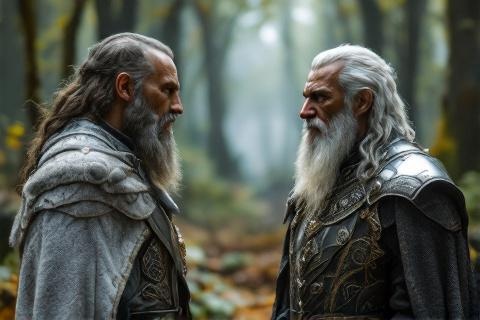
The Sindar: Twilight Elves of Beleriand
Exploring the Silver-grey Folk and Their Legacy in Tolkien's Middle-earth
Origins of the Teleri and the Great Journey

The Teleri, who would later give rise to the Sindar, emerged as
the third and most numerous clan of the Elves who awakened
beneath the stars at Cuiviénen. These people, who would become known as the
Third Kindred of the Eldar, were marked from the beginning by their deep love of
water and their melodious voices, which earned them the name Lindar, the
Singers.
When the Valar summoned the Elves to undertake the Great Journey
westward to Valinor, the Teleri began their long march but
moved more slowly than their kindred. While the Vanyar and
Noldor pressed ahead eagerly, the Teleri lingered behind, taking
time to explore the lands they passed through and showing less urgency to reach
the Blessed Realm.
The fate of the Teleri changed forever when their lord Elwë encountered the
Maia Melian in the forest of Nan Elmoth. Enchanted by her
otherworldly beauty and wisdom, Elwë fell into a deep trance while holding her
hand, standing motionless beneath the stars for many years. This event caused
many of his people to halt their westward journey, refusing to continue without
their beloved leader, and thus they became known as the Sindar, the Grey Elves
of Beleriand.
The Realm of Doriath

After Elwë awakened from his trance, he established the kingdom of
Doriath with Melian as his queen, taking the name Elu Thingol
in the Sindarin tongue. Under their rule, Doriath became a realm of
extraordinary beauty and power, where the wisdom of a Maia merged with the
strength and creativity of the Eldar. Their seat of power grew to become the
mightiest kingdom of the Sindar in Middle-earth.
To protect their realm from the growing threats of
Morgoth, Melian created an unseen barrier of enchantment
known as the Girdle of Melian. This magical protection encircled the forests of
Neldoreth and Region, forming an impenetrable maze of shadows and bewilderment
that none could pass without the permission of Thingol and Melian. The Girdle
served as an invaluable defense throughout the Wars of Beleriand.
At the heart of Doriath stood Menegroth, the Thousand Caves, a magnificent
underground city carved with the help of the Dwarves of Belegost. The halls of
Menegroth were illuminated with countless lamps, its pillars hewn in the
likeness of great beech trees, with golden leaves and silver branches interwoven
with carved birds and beasts. The walls were adorned with tapestries depicting
the lands of the Valar and scenes from the history of the Eldar.
Doriath stood as the greatest and most powerful of all Sindarin realms in
Beleriand, serving as a beacon of elvish culture and strength. Under the
leadership of Thingol and Melian, it became a center of learning, artistry, and
resistance against the forces of darkness. The realm's influence extended far
beyond its borders, shaping the politics and culture of Beleriand throughout the
First Age.
Culture and Crafts of the Grey-elves
The Sindarin language evolved from the common Telerin tongue during the long
years the Grey Elves dwelt in Beleriand. This language became the most widely
spoken elvish tongue in Middle-earth, eventually becoming the common speech of
all Elves in Beleriand and later influencing the languages of Men. Its beauty
and sophistication reflected the rich cultural development of the Sindar during
their separation from their kin.
The Sindar developed their own unique cultural achievements, becoming renowned
for their exceptional musical abilities, their skillful crafting of weapons and
jewelry, and their masterful understanding of the forests. Their songs echoed
through the woods of Beleriand, and their craftsmanship, though different from
that of the Noldor, showed remarkable sophistication and beauty.
A significant relationship developed between the Sindar and the Dwarves of the
Blue Mountains, particularly those of Belegost and Nogrod. This alliance led to
a productive exchange of knowledge and skills, with the Dwarves teaching the
Sindar much about metalwork and stonecraft, while the Elves shared their
knowledge of language and music. This cooperation reached its pinnacle in the
construction of Menegroth.
The Grey Elves became known for their distinctive appearance and style, favoring
silver-grey clothing that reflected their name and their twilight nature. Their
jewelry work showed a preference for silver over gold, and they crafted
beautiful ornaments using pearls and other precious materials found in
Beleriand. Their aesthetic sense influenced all aspects of their culture, from
their architecture to their weapons and daily implements.
The Coming of the Noldor

When the Noldor returned to Middle-earth at the beginning of the First Age, the
Sindar's reactions were mixed with both joy and suspicion. The return of their
kindred brought both opportunities and complications, as the Noldor arrived with
tales of the Blessed Realm but also bore the shadow of dark deeds in Valinor.
The relationship between the Sindar and the Noldor proved complex and often
strained, particularly after the truth about the Kinslaying at Alqualondë came
to light. Despite their shared ancestry, cultural differences and political
tensions created barriers between the two groups, though many strong friendships
and alliances were still formed.
The arrival of the Noldor brought significant technological and cultural changes
to Beleriand, as they shared their advanced knowledge of crafts and warfare. The
Sindar, while maintaining their own traditions, adopted many Noldorin
innovations, particularly in metalwork and the making of weapons necessary for
the war against Morgoth.
Following the revelation of the Kinslaying, Thingol made a momentous decree
banning the use of Quenya, the language of the Noldor, throughout his realm.
This decision had far-reaching consequences, cementing the position of Sindarin
as the dominant elvish language in Middle-earth and creating a lasting
linguistic division between the Sindar and their Noldorin kin.
Thingol and the Silmaril

The quest for the Silmaril, initiated when Thingol
demanded one as bride-price for his daughter
Lúthien's hand in marriage to
Beren, set in motion a chain of events that would profoundly
affect the fate of Doriath. This seemingly impossible task led to one of the
greatest tales of the First Age, as Beren and Lúthien succeeded in wresting a
Silmaril from Morgoth's iron crown.
The possession of the Silmaril brought both glory and doom to Doriath. While its
presence added to the realm's splendor and power, it also drew the attention of
enemies both within and without. The jewel's radiance illuminated the halls of
Menegroth with a light from the ancient West, but its presence would ultimately
contribute to the kingdom's downfall.
Thingol's growing desire for the Silmaril, enhanced by its incomparable beauty,
led him to commission the Dwarves to set it in the Nauglamír, the legendary
Necklace of the Dwarves. His pride and the Dwarves' desire for the jewel led to
his death in their hands, marking the beginning of Doriath's end.
The destruction of Doriath came in waves, first through the Dwarves' assault to
claim the Silmaril, then through the final devastating attack by the sons of
Fëanor, bound by their oath to reclaim their
father's creation. The fall of this great realm marked one of the most tragic
events of the First Age, scattering the Sindar and forever changing the
political landscape of Beleriand.
The Sindar and the Children of Men
The Sindar's early encounters with the first Men to enter Beleriand, the People
of Bëor, established patterns of friendship and alliance that would shape the
history of both races. These interactions were initially cautious but gradually
developed into strong partnerships, particularly in the fight against Morgoth's
forces.
The marriage of the mortal Beren to Lúthien, daughter of Thingol and Melian,
marked a pivotal moment in the relations between Elves and Men. This union,
though initially opposed by Thingol, became a symbol of hope and possibility,
establishing a precedent for future unions between the two races and creating a
lineage that would profoundly influence the destiny of Middle-earth.
The fostering of Túrin Turambar in Doriath
demonstrated both the nobility and the tragedy inherent in the relationships
between Elves and Men. Thingol's acceptance of Húrin's son and his treatment of
him as his own child showed the potential for deep bonds between the races,
though Túrin's ultimate fate would bring great sorrow to the realm.
These relationships established during the First Age set precedents that would
influence interactions between Elves and Men throughout the history of
Middle-earth. The alliances, friendships, and marriages between the two races
created lasting bonds that would continue to shape events long after the end of
the First Age.
Legacy of the Grey-elves

After the War of Wrath and the reshaping of
Middle-earth, the surviving Sindar adapted to the changed world of the Second
Age. Many joined their Noldorin kin in establishing new
realms, while others remained in Middle-earth, maintaining their distinct
cultural identity while adjusting to the new age.
The Sindarin language and customs exerted a profound influence on later elvish
realms, particularly in Lindon and Lothlórien. Their
artistic traditions, music, and craftsmanship continued to flourish and evolve,
enriching the culture of the Elven havens and kingdoms that emerged in the
Second and Third Ages.
The fate of the remaining Sindar in Middle-earth followed various paths. Some,
like Oropher and his son Thranduil, established new
kingdoms in the woodland realms, while others chose to dwell in havens such as
the Grey Havens under Círdan the Shipwright.
Many eventually heard the call of the Sea and departed for the Undying
Lands.
The legacy of the Sindar endured throughout the history of Middle-earth, their
influence visible in everything from the prevalent use of their language to
their architectural styles and artistic traditions. Their wisdom, skills, and
cultural achievements continued to shape elvish society and impact the other
free peoples of Middle-earth long after the end of the First Age.
